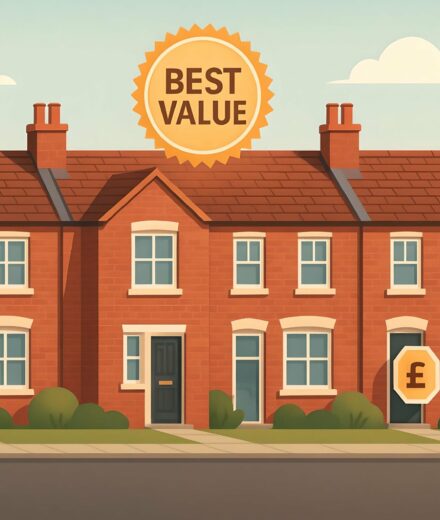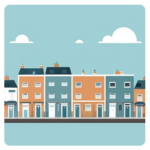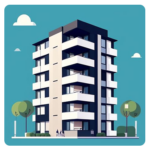

House Prices > Durham
| Year | Average Price | Transactions |
|---|---|---|
| 2025 (proj.) | £181,200 | 2,145 |
| 2024 | £178,600 | 1,700 |
| 2023 | £175,200 | 2,093 |
| 2022 | £180,300 | 2,580 |
| 2021 | £185,600 | 2,662 |
| 2020 | £175,000 | 1,846 |
| 2019 | £169,300 | 2,125 |
| 2018 | £164,400 | 2,007 |
Durham’s property market has danced a sprightly, occasionally unpredictable waltz since 2018. If you had called it steady, you’d have been half-right and mostly optimistic. Average house prices are like the River Wear after a rainy week: mostly ascending, with a few gurgling dips along the banks.
Transaction volumes are another story. These have see-sawed with finger-drumming unpredictability, resembling the queue at a Greggs on a Saturday morning — boisterous, thinning, swelling again. Peaks minted in 2021’s perfect storm, as lockdown savings came out to play and buyers went homehunting with extra gusto. Since then, transactions have steadily dropped — but take heart, the projection for 2025 gives us a glimmer of a cheeky rebound.
If you’re weighing up your next move, see what your home might fetch in Durham today – you might be in for a pleasant surprise, or at least not a bad one.
So, what can we establish? Durham’s property story is far from finished. Expect more price teetering and a few surprises, but rarely a dull moment.
Weighing up a move? Browse through our range of Durham homes on the market.

Avg. Property Price: £362,500
Avg. Size of Property
1,478 sq/ft
Avg. Cost Per Sq/ft
£251 sq/ft
Total transactions
627 (since 2021)

Avg. Property Price: £206,200
Avg. Size of Property
991 sq/ft
Avg. Cost Per Sq/ft
£208 sq/ft
Total transactions
1,135 (since 2021)

Avg. Property Price: £205,400
Avg. Size of Property
955 sq/ft
Avg. Cost Per Sq/ft
£214 sq/ft
Total transactions
832 (since 2021)

Avg. Property Price: £132,600
Avg. Size of Property
629 sq/ft
Avg. Cost Per Sq/ft
£202 sq/ft
Total transactions
93 (since 2021)
Durham property prices by type reveal a market shaped by both heritage and buyer pragmatism, with each segment finding its pace over the past few years. The city’s distinctive blend of university life, cathedral backdrops, and winding cobbled streets feeds a housing sector that’s as layered as the River Wear on a misty winter morning.
Detached homes stand out as the top choice for those craving more room, with average sizes stretching to a roomy 1,480 sq/ft. While the £362,300 price tag requires a substantial investment, it’s clear from the 620 transactions since 2021 that this market has not lost its momentum. Detached owners are often seeking privacy, generous gardens, and that rare sense of escape. The suburbs remain dotted with such properties, drawing families and remote workers seeking tranquillity without straying too far from city perks.
Semi-detached and terraced properties make up the bread and butter of Durham’s market, together clocking up a whopping 1,957 transactions in just a handful of years. With average prices holding close (both just over £200,000), they appeal to a wide swathe of buyers. The average size, 990 sq/ft for semis and 960 sq/ft for terraces, offers a sensible compromise between cost, comfort and manageable upkeep. For investors with their sights set on rental potential, these homes are moving quicker than a rainy-day dash down Saddler Street.
Durham’s flats, meanwhile, chart a different course. With a notably leaner 630 sq/ft average, they typically serve as the springboard for first-time buyers or students. Their less daunting average price of £132,600 and a cost efficiency of £200 per sq/ft reflect both supply challenges and a steady undercurrent of demand. The fact that flats only account for 93 transactions hints at a low supply pipeline paired with fierce competition for available units.
At the far end of the market, a standout £830,000 average price for the city’s largest properties (with a staggering 3,380 sq/ft footprint) attracts a more exclusive clique. Here, the £250 per sq/ft aligns with detached prices, but with only one transaction tracked in that time, opportunities are as rare as a ticket to the cathedral’s Christmas concert.
Even so, Durham’s per square foot price differentials across property types remain surprisingly tight, reflecting a stable and level playing field for both upsizers and those with budget limitations. In a nutshell, those able to compromise a little on size can still secure comfort without stretching their wallets unduly.
For buyers mulling over value, location and property type, the data suggests there’s something for nearly every taste and budget, if you’re willing to be nimble and act swiftly. Keen to pinpoint your home’s market value before making your move? Discover what your property could be worth in the current Durham market.
| District | Avg Price (£) | Transactions |
|---|---|---|
| DH1 | £239,000 | 5,208 |
| DH6 | £134,500 | 4,828 |
| DH7 | £151,100 | 5,115 |
Durham’s property market continues to surprise, with prices ricocheting between districts like a cricket ball bouncing down Elvet Bridge. What stands out is just how strikingly diverse the district-by-district pricing appears—there’s more here than the traditional “north-south divide” narrative would suggest.
DH1, anchored by central Durham, marks out its territory as the premium choice for buyers. The area’s temptingly central location—walking distance to the cathedral, riverside, and university—morphs into higher prices and, perhaps just as importantly, a robust number of successful property transactions. Those who can afford to settle here are clearly ready to invest in a slice of Durham’s ancient core, and this appetite shows no sign of fading.
Step out from the city’s beating heart and values start to tumble, but not without reason. Both DH6 and DH7 offer accessibility, good routes towards the A1(M), and a mix of rural and suburban living. Value hunters will find that property here comes at a much more attractive price point. Yet, interestingly, these districts are not outstripped when it comes to volume—sales activity is consistently buoyant. In fact, it’s almost as if buyers, keen to stretch their budgets, are flocking to these districts faster than students rushing for Greggs on Silver Street.
What will the map of property value look like by 2030? Expect the gravitational pull of DH1 to remain magnetic, yet rising demand in DH6 and DH7 could see these areas gradually close the gap. Investment interest is already brewing. Savvy buyers, especially those pondering Durham’s hottest investment streets for 2025, are turning their eyes to the “affordable edge” districts, looking to ride the next wave of uplift.
Durham’s market is dynamic, locally driven, and fiercely unpredictable. Buyers here play for keeps, whether they’re seeking prestige, prospects, or plain old good value.
Please also check out the following areas in Durham for further insights:
| City | Avg Price (£) | Transactions |
|---|---|---|
| Spennymoor | £137,700 | 2,786 |
| Houghton Le Spring | £159,500 | 4,392 |
| Chester Le Street | £166,400 | 4,261 |
| Ferryhill | £106,700 | 1,470 |
| Crook | £127,400 | 1,610 |
| Stanley | £107,200 | 3,075 |
| Wingate | £145,300 | 632 |
| Washington | £157,100 | 4,018 |
| Peterlee | £106,000 | 3,036 |
| Seaham | £133,800 | 2,405 |
The Durham property market moves in mysterious ways, much like a spring morning on the Wear that can’t decide between sunshine or mist. Step outside the city’s historic centre, and you’ll find house prices that twist and turn more than the River Wear itself. Every neighbouring town tells a different story—sometimes bargain, sometimes surprise, sometimes the kind of competition that gets buyers’ hearts racing.
If you’re weighing up where to settle, here’s what really leaps out:
It’s not all smooth sailing though. Some areas, despite their tempting prices, see fewer deals cross the line each year—a sign that local quirks or slower turnover might be at play. And sometimes, the market here surprises you, zig-zagging just when you thought you’d spotted a trend. This is Durham after all; predictability isn’t its style.
If you’re thinking about making your move, remember—Durham’s housing market can change direction faster than a Wearside breeze. Stay nimble, shop smart, and don’t be afraid to explore those neighbouring towns. You might just find your perfect fit where you least expect it.
Kindly remember, these figures use only overall averages, not adjusted values.
Trends could appear less clear without adjusting for size or square foot price. For detailed comparisons, head to our blog.
We reimagine what street-level property data should look like. Using structured government information (Land Registry, EPC), passed through our remarkably adaptable model, we purge the fluff and leave only crisp pricing intelligence. See why our approach is more balanced
Our site uses cookies. By using this site, you agree to the Privacy Policy and Terms of Use.